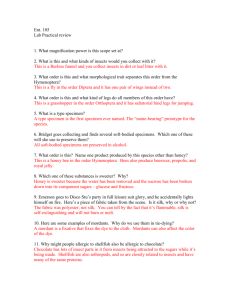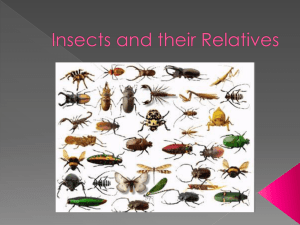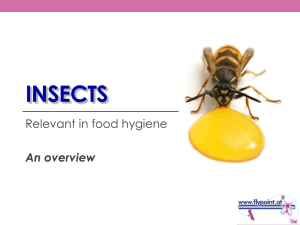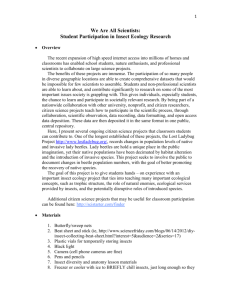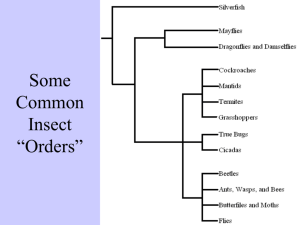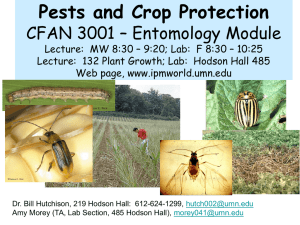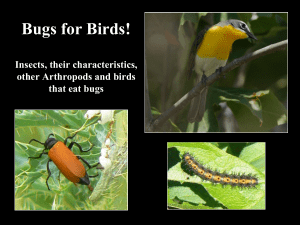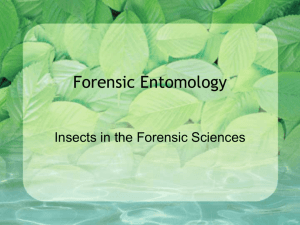Insects & Medicine
advertisement
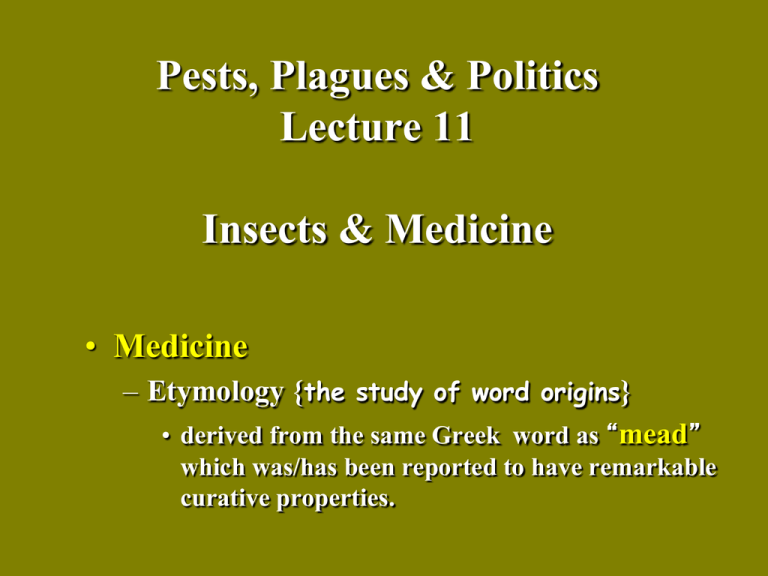
Pests, Plagues & Politics
Lecture 11
Insects & Medicine
• Medicine
– Etymology {the study of word origins}
• derived from the same Greek word as “mead”
which was/has been reported to have remarkable
curative properties.
Key Points
•
•
•
•
•
Wound Debridement
Medicinal properties of honey
Insect Sutures
Aphrodisiacs
Historic use of insects as medicine
Insects as healing agents
• Maggot Debridement Therapy
Fly larvae as agents of antisepsis
– Sepsis (Gr. ‘sepsis’ = putrefaction)
– “poisoning caused by the absorption into the
blood of pathogenic micro-organisms”
• Discovered in the U.S. Civil War that flyblown wounds healed faster & cleaner.
• Caused the surgeons to investigate this
phenomenon.
• Wound Myiasis
– “an infection of the organs or tissues of
man or animals by fly larvae that, for at
least a period of time, feed upon the
living or dead tissues.”
Flies Responsible
• Diptera
– family Calliphoridae - the BLOW FLIES
– family Sarcophagidae - the FLESH FLIES
– in their larval stage they feed on “meat”
• the buzzards of the insect world
– some species feed on living tissue
• be careful in your selection of species.
– The commonly found/used species
• Phormia regina - P. terraenovae & Lucillia
sericata
Flesh Fly
Blow Flies
• Surgeons began intentionally infesting wounds
with fly larvae.
• Today:
– eggs are surface sterilized and placed on a
food source (horse meat normally)
– 2 day old larvae inoculated into wound
– larvae flushed out with saline
in 3 or 4 days and younger
larvae added as necessary.
Phormia regina
Eats only dead tissue
“And the gilded little fly
does lecher in my sight.
Let copulation thrive!!”
Shakespeare - King Lear
Calliphoria vomitoria
Bad choice.
This species will eat
living tissue.
The working end of a
blow fly larva.
You may wish to avert your eyes
Blow Flies
• Maggot debridement therapy
– especially helpful in cases of bone infections
(osteomyelitis)
– discovered that not only did the larvae assist
in cleanup of dead tissue, but they also
produced an endogenous antibiotic
– plus they secrete ammonia & calcium
carbonate which promote healing
– A resurgent technology
• see: BIOMAGGOT.com
HONEY as medicine
• A long history as a mendicant
– ancient Egyptians used it as a wound
dressing
– practiced to this day.
• Is is wise to do so??
– YES
– and here’s why:
Honey in medicine
• Three mechanisms that account for the
medicinal properties of honey
– pH
• average of 3.9 - an acid medium
– Hyperosmotic
• low moisture content dehydrates (via osmosis)
microbial life that enters honey
– Inhibine
• a term coined in the mid-1930ties to describe an
“unknown” antibiotic property of honey
Honey In Medicine
• A host of testimonial claims for the
efficacy of honey
–
–
–
–
–
–
burns
abrasions
bed wetting
insomnia
hyperactivity
ad nauseum
She almost had it right!!!
Insect Sutures
Soldier ants
A nice example of polymorphic caste extremism.
Major and minor worker of E. burchelli
Army ant soldier
Ant Stitches
• An ancient practice
– India; 3,000 yrs. BP
– Known also from the mid-East & So.
America
• Commonly used ant genera
– Camponotus - carpenter ants
– Atta - leaf-cutter ants
– Eciton - army ants
Insects AS Medicine
• Blister Beetles
– source of CANTHARIDIN
• a blistering agent
• hexahydro-3,7-dimethyl-4, 4epoxyisobenzofuran-1, 3-dione
• (just in case you wanted to know)
• the infamous SPANISH FLY
– a putative aphrodisiac
A bit of mythology
Cantharidin
• A defensive chemical produced by beetles
to ward off predator attacks
– reflex bleeding (autohemorrhization)
– dried beetles contain up to 1% cantharidin by
weight
– toxic, blistering agent
• 30 mg a fatal dose for humans
– Recommended by such worthies as
• Hippocrates & Galen ‘…to stimulate
certain internal organs.’
The real Spanish Fly
•
•
•
•
Order Coleoptera
Family Meloidae
G.& s. Lytta vesicatoria
2,000 species of blister beetles
– 68 species in the genus Lytta
– Many are native to the countries surrounding the
Mediterranean Sea.
[note: lytta = rage (Gr.): vesica = blister (L.)]
An African “Spanish” Fly
• In Zimbabwe
– Genus Mayalabris
– Known locally as “vuka-vuka”
•vuka means “wake up”
– Most potent concoction is known as
“Squirrel’s Jump”
• squirrels considered
to be very romantic
animals…
BLISTER BEETLES
SEE, it works!!!!!
Insects as aphrodisiacs
• 2002 Review article by Prischmann & Sheppard
24 insect families with “proven” efficacy by various species
(beetles, bugs, bees, wasps, ants moths, et alia.
• Used as general aphrodisiacs, love potions, E.D.
“stimulants” [entomological Viagra], potency
enhancements & on and on.
• A history as old a Hippocrates [the father of
medicine] and Galen {2nd century Greek}
• It still sells today!
Bee & Wasp Venoms
• Desensitization of humans hypersensitive
to Hymenopteran venoms
• Used in controlled, serial dosages
– 3 to six months
– begins with the injection of 1/200th of the
venom of one bee or wasp
– ends with an injection of equivalent venom
of two bees or wasps
• First licensed by the FDA in 1976
• Fully licensed in 1980
Bee Venom
• Vast anecdotal base for help (or “cure) for:
– Arthritis
– Bursitis
– M.S.
• NIH-OAM funded an M.S.
study in 1998
• BVT very popular in the world of
• alternative medicine.
Insects AS Medicine
• “Mea
culpa est ignorami”
• Insects in pharmacopoeia (drug ref. Books)
– Two basic principles observed
• Ingredients as repulsive as possible
• insect used must bear some resemblance of the
complaint or suffering.
• Insects used in the symbolic transfer of disease
• ancient dogma: “similia smilibus curentur”
• also known as the Doctrine of Signatures or
• Sympathetic Medicines - Law of Similarity
Earwigs for Deafness
• Elizabethan England
• Dried & powdered earwigs mixed with
rabbit urine & poured into the ears twice
daily.
• Earwigs
– Order DERMAPTERA (“skin” wing)
– small group of nocturnal scavengers that do
NOT crawl into human ears.
The European Earwig
“Mother & Child(s)”
Post-natal care,
& rather rare in the
insect world.
Order DERMAPTERA
Cockroach Soup
Jazz great Louie Armstrong related that
his mother would often feed him cockroach
soup at times of childhood illness.
Bed Bug Broth
• Elizabethan England (again)
– as a cure for Malaria
Insects as medicine
• Grasshoppers to stop the fits
– NY-late 19th century
• Cockroaches for measles
– place the insect in a jar or under a thimble
and allow it to die - thereby “transferring”
the disease from human to bug.
• Singing insects for ear & throat problems
– Europe during the Middle Ages
Insects as medicine
• For baldness
– the use of hairy insects
– Pliny in HISTORIA NATURALIS
• “The heads of flies, applied fresh to the bald
place is a convenient medicine for the said
infirmity & defect.”
– 1743: English Medical Dictionary
• “Powdered bees contribute to the growth of hair”
Spiders as medicine
• Tarantism
– a nervous disorder characterized by hysteria
& a mania for dancing
– a form of anxiety displacement
– believed to be caused by spider bites
• First observed in the Italian town of
TARANTO in the 16th & 17th centuries
– from which the name Tarantula is derived
– from which the folk dance “Tarantella” is
derived
Recommended cure for Tarantism was to eat live spiders!!!
YUMMY!!!
Watch the Tarantella!
South America
• Theraphosa blondi,
• The Goliath Bird-eater
• the largest spider in the world
• To cook, it must be roasted in fire
to “burn off the toxic hairs”
• Roasted for roughly seven
minutes, and then cracked open
like crabs
• Abdomen has actual “meat” in it
• Supposedly tastes like smoked
crab
Key Points
•
•
•
•
•
Wound Debridement
Medicinal properties of honey
Insect Sutures
Aphrodisiacs
Historic use of insects as medicine
